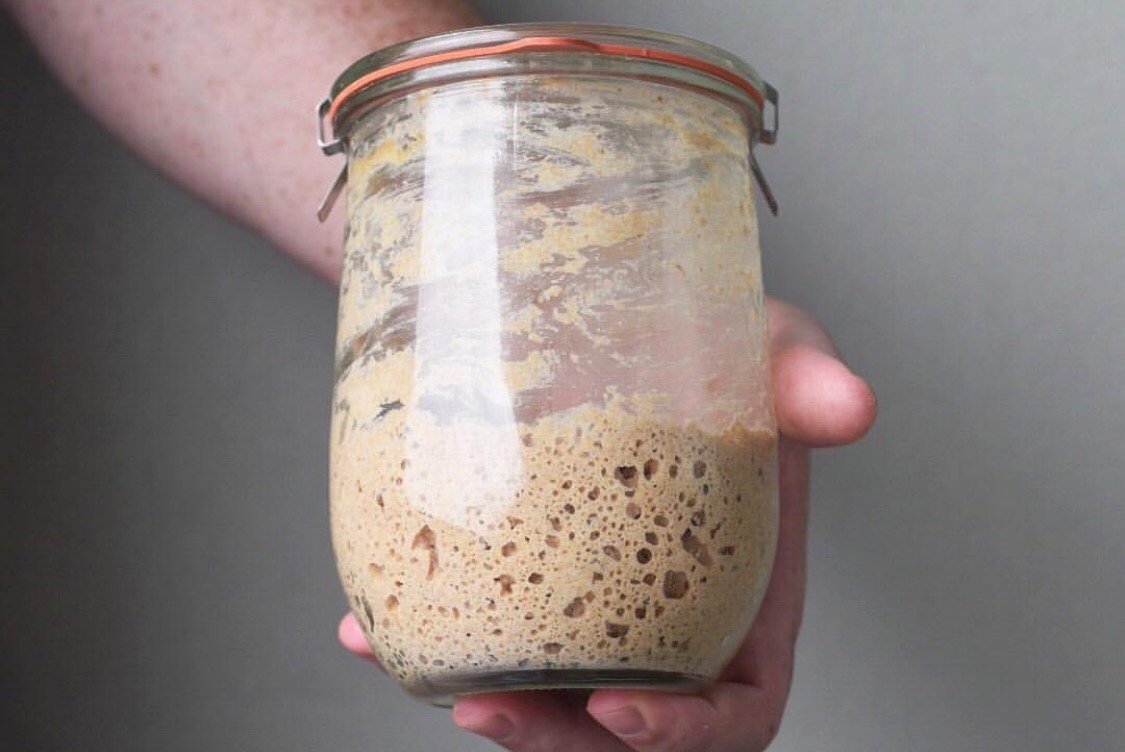Making and maintaining a sourdough starter may seem complex, but it is actually quite simple. Wild yeast is in the air all around us, and with a few simple steps you can harness it and make a starter that will leaven homemade sourdough bread beautifully. If you do not have access to an already maintained sourdough starter, create your own!
Sourdough starters are finicky by nature and every variable (the temperature of your house, the flour, the mineral content of the water, and the temperature of the water) can affect the speed in which the yeast activates and the amount of time it takes for your sourdough starter to feed and rise in an expected manner. Above all, sourdough starters like consistency, which is a continuing theme in the directions that follow for creating and maintaining your sourdough starter.
The flour you use makes a big difference in the behaviour of your sourdough starter. Whole grain flours tend to work much faster, but can be difficult to work with. We have developed a method for creating a sourdough starter with our Flourist Sifted Red Spring Wheat Flour, which we have found behaves the closest to standard commercial bread flour {but with without the nasty additives}, and creates a sourdough starter that is easy to use and maintain. You can also use the Flourist Sifted Red Fife Flour for great results too. A kitchen scale is recommended for anyone looking to experiment with sourdough baking.
Making a Sourdough Starter
Combine equal parts Flourist Sifted Red Spring Wheat Flour and room temperature water (we prefer 100g of each). Cover and let it sit somewhere the temperature is consistent for 24-48 hours. Check after 24 hours to see if any bubbles have formed in the mix. The presence of bubbles is an indication that the yeast from the air is feeding on the sugars in the flour and is releasing carbon dioxide. It is important to note that you should ideally feed your starter at the same time each day, so choose a time either in the morning or evening depending on what works with your schedule.
Once you have reached the stage of seeing visual bubbles, you need to begin feeding your starter. It will take about five or six "feedings" before it begins to behave consistently and is ready for you to begin baking with. Ideally, feed your new starter for a week before using it to ensure that it has gotten used to its routine of feedings.
Feeding a Sourdough Starter
In order to maintain a standard amount of sourdough starter, weigh out 100g of starter for the feeding and discard the rest. Feed with 100g Flourist Sifted Red Spring Wheat Flour and 100g water each time. Discarding the extra may seem like a lot of waste, but once your starter is ready to be used the discard can be used in so many different recipes such as waffles, crackers, and muffins. Perform the first feeding and let sit for 24 hours.
Repeat this step consistently, feeding your starter at the same time each day, for at least 5 days. Your starter is ideal to bake with when it has doubled in size after 24 hours, is bubbly, and has a nice sour smell. It is ideal to maintain your starter in this manner moving forward.
Once you are ready to use your starter you may find that you need to increase the amount that you have for your recipe. A good rule of thumb is to maintain a ratio of 1:1:1 (equal parts sourdough starter, water, and flour). The amount can be increased or decreased as needed. It is nice to keep a small amount when you are not intending to use it for baking as then there is less discard waste to manage.
Maintaining your starter at room temperature ideally requires a daily feeding. If you find this too cumbersome, you can keep your starter in the fridge and feed it once a week. If you keep it in the fridge it is a good idea to let it sit out after feeding for about 8-12 hours, so that the yeast has time to reactivate itself before putting it back in the fridge. Putting your starter in the fridge "hibernates" the yeast, so we suggest you remove it from the fridge and feed it for at least one day, ideally two, before you use it again to make bread. This gives the yeast time to "wake up" and become active again.
Ready to bake? Get our Basic Sourdough Boule recipe here.
Photo Credit: Flourist customer Laura Brehaut



Comments
Hi!
What’s the best size jar to use for a sourdough starter? I have a 2pint mason jar – is that fine?
Hi Katleen!
Your starter is ready to go as soon as you bring it home from the bakery. If you plan to bake a lot throughout the week, we recommend to store your starter on the counter and feed it daily. If you only plan to bake once a week or less, we recommend you store your starter in the fridge and feed it once per week for maintenance. In the case of the latter, remove your starter from the fridge the night before you plan to bake and feed it then and keep it on the counter until you’re ready to make dough. Send us an email at info@flourist.com if you have any other questions!
Hi Francesco,
Yes, you can use rye to feed the starter, but be prepared for a lot of activity. It will likely rise and fall very quickly. You can also try blending with a sifted flour.
Hey guys! Can I use your rye to make my starter?
Thanks!
Hi, I am a total novice with sourdough starter. My order arrived today and I am unsure of a few things.
1. Where should I store it? Is the storage temperature important?
2. When should I begin to “feed” it?
3. May I use it immediately or must I feed it for a certain amount of time?
My first attempt at making a sourdought starter – my discard has more bubbles and rise than my starter. Can I use the discard instead of the starter for bread making ?
Hi Cody – it sounds like your sourdough starter needs a bit of a jumpstart – I would suggest feeding it for a few days with 50% sifted and 50% whole grain flour – that should help boost its activity.
Hi Banu – You can use Whole Grain to make a sourdough starter but you may need to feed it more frequently as it will be more active.
Hi Krista – it’s a good idea to change to a clean container every few feedings but not necessary to clean it after each feeding. Use slightly warmer water if your house is on the cooler side.
Hi Freda – You can definitely use Sifted Red Fife!
My starter doesn’t “double in size” after feeding…maybe +20% at best. And it still doesn’t pass the “float on water” test—almost, but not quite. I started it 9 days ago and feed it daily. What’d up, do you think? It smells good…
Can I make the sourdough starter with Red Fife or Red Spring, not sifted flour?
Hi! I just wanted to share that I tried this method, using sifted red spring flour and my starter would have very little activity, and on day 3-5 start growing fuzzy mould!!! This happened 3 separate times!
I then tried the same 1:1:1 ratio, but 50% rye / 50% whole grain red fife and saw success almost immediately. If anyone is having trouble try a whole grain flour instead!
Now that my starter is strong I can feed with sifted red spring with no issues. It just didn’t work for me to start with it!